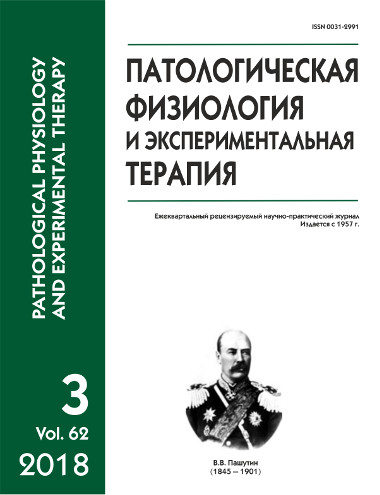Activity of the glutathione system and NADPH-generating enzymes under the action of melatonin during cerebral ischemia/reperfusion in rats
Abstract
Due to the involvement of oxidative stress in brain ischemic damage and to antioxidant properties of the hormone melatonin, it was relevant to study the effect of melatonin on antioxidant enzymes and some enzymes of oxidative metabolism that limit free radical processes in pathology. The aim was to study the effect of melaxen, a melatonin analogue, on activities of glutathione peroxidase, glutathione reductase, and glutathione transferase, content of reduced glutathione, and activities of glucose-6-phosphate dehydrogenase and NADP-isocitrate dehydrogenase, which can supply NADPH to the glutathione antioxidant system, in the brain and blood serum of rats with cerebral ischemia/reperfusion. Methods. White male rats were used in the study. Cerebral ischemia was induced by 30-min occlusion of common carotid arteries; reperfusion was induced by removing the occlusion. Activities of enzymes and concentration of reduced glutathione were measured spectrophotometrically. Results. Melaxen reversed the increased enzyme activities and the reduced glutathione level induced by the pathological conditions returning them to the control values. This can be explained by inhibition of free radical processes under the action of the antioxidant melatonin and its neuroprotective effect in oxidative stress associated with disorders of cerebral circulation. The result is decreased mobilization of the antioxidant system and some enzymes of oxidative metabolism, which act as a single system in the adaptive response. Conclusion. The study justified further investigation of the possibility for using melatonin-correcting agents for pharmacological correction of metabolic changes in such pathologies.
Downloads
References
2. Reiter R.J. Oxidative processes and antioxidative defense mechanisms in the aging brain. FASEB J. 1995; 9: 526-33.
3. Kirova Yu.I. Role of the glutathione system in regulation of redox status in the rat cerebral cortex under hypoxia. Patologicheskaya Fiziologiya i Eksperimental`naya terapiya. 2014; 58(4): 40-7. (in Russian)
4. Quera Salva M.A., Hartley S. Mood disorders, circadian rhythms, melatonin and melatonin agonists. J. Cent. Nerv. Syst. Dis. 2012; 4: 15-26.
5. Reiter R.J., Tan D.X., Terron M.P., Flores L.J., Czarnocki Z. Melatonin and its metabolites: new findings regarding their production and their radical scavenging actions. Acta Biochimica Polonica. 2007; 54(1): 1-9.
6. Arushanian E.B., Schetinin E.V. Melatonin as a universal modulator of any pathological processes. Patologicheskaya Fiziologiya i Eksperimental`naya terapiya. 2016; 60(1): 79-88. (in Russian)
7. Maldonado M.D., Murillo-Cabezas F., Terron M.P., Flores L.J., Tan D.X., Manchester L.C. et al. The potential of melatonin in reducing morbidity-mortality after craniocerebral trauma. J. Pineal. Res. 2007; 42(1): 1-11.
8. Lekic T., Hartman R., Rojas H., Manaenko A., Chen W., Ayer R. et al. Protective effect of melatonin upon neuropathology, striatal function, and memory ability after intracerebral hemorrhage in rats. J. Neurotrauma. 2010; 27(3): 627-37.
9. Wang J.Z., Wang Z.F. Role of melatonin in Alzheimer-like neurodegeneration. Acta Pharmacol. Sin. 2006; 27: 41-9.
10. Srinivasan V., Pandi-Perumal S.R., Maestroni G.J., Esquifino A.I., Hardeland R., Cardinali D.P. Role of melatonin in neurodegenerative diseases. Neurotox Res. 2005; 7: 293-318.
11. Watson N., Diamandis T., Gonzales-Portillo C., Reyes S., Borlongan C.V. Melatonin as an antioxidant for stroke neuroprotection. Cell Transplant. 2016; 25(5): 883-91.
12. Al-Omary F.A. Melatonin: comprehensive profile. Profiles Drug Subst. Excip. Relat. Methodol. 2013; 38: 159-226.
13. Bul’on V.V., Hnychenko L.K., Kovalenko A.L., Alekseeva L.E. Sapronov N.S. Correction of the effects of brain postischemic reperfusion injury with cytoflavin. Bulluten eksperimentalnoy biologii i meditsiny. 2000; 129(2): 149-51. (in Russian)
14. Lowry O., Rosenbrough N., Farr A., Randall R.J. Protein measurement with the Folin phenol reagent. J. Biol. Chem. 1951; 193(1): 265-75.
15. Sedlak J., Lindsay R.H. Estimation of total, protein-bound, and nonprotein sulfhydryl groups in tissue with Ellman’s reagent. Analytical Biochemistry. 1968; 25: 192-205.
16. Glanc S. Medical and biological statistics [Meditsinskaya i biologicheskaya statistika]. Moscow: Praktika; 1999. (in Russian)
17. Safonova O.A., Popova T.N., Panchenko L.F. Effect of 2,4-dimethoxyphenylbiguanide on the glutathione system activity in the rats tissues under brain ischemia-reperfusion. Bulluten eksperimentalnoy biologii i meditsiny. 2011; 151(5): 488-91. (in Russian)
18. Popova T.N., Safonova O.A., Stoljarova A.O. Oxidative status of the rats tissues under the melaxen introduction on the background of the cerebral ischemia / reperfusion development. Biomeditsinskaya khimiya. 2016; 62(5): 561-65. (in Russian)
19. Bespjatykh A.Ju., Burlakova O.V., Golichenkov V.A. Melatonin as an antioxidant: basic functions and properties. Uspekhi sovremennoy biologii. 2010; 130(5): 487-96. (in Russian)
20. Reiter R.J., Tan D.Х., Terron M.P., Flores L.J., Czarnocki Z. Melatonin and its metabolites: new findings regarding their production and their radical scavenging actions. Acta Biochimica Polonica. 2007; 54(1): 1-9.
21. Sanchez-Barcelo E.J., Martinez-Campa C.M., Mediavilla M.D., Gonzalez A., Alonso-Gonzalez C., Cos S. Melatonin and melatoninergic drugs as therapeutic agents: rameltion and agomelatine, The two most promising melatonin receptor agonist. Recent patents on endocrine, metabolic and immune drug discovery. 2007; 1(2): 142-51.






